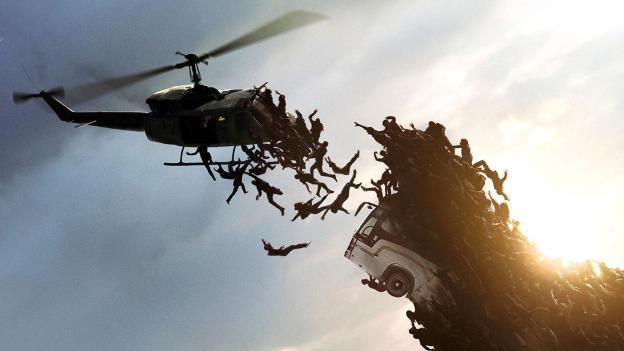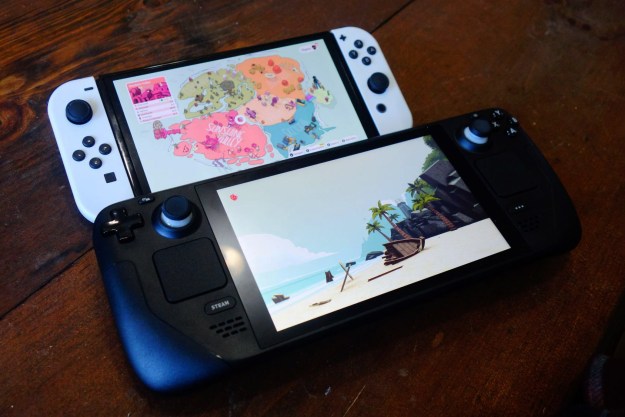 Bringing something fresh to the crowded zombie-movie genre isn’t easy, but director Marc Forster’s World War Z manages to do just that by offering a global perspective on the proliferation of the living dead. But for many people, it wasn’t the scope of the film that first caught their attention – it was the image of a seemingly never-ending waves of zombies featured in several scenes from the first trailer.
Bringing something fresh to the crowded zombie-movie genre isn’t easy, but director Marc Forster’s World War Z manages to do just that by offering a global perspective on the proliferation of the living dead. But for many people, it wasn’t the scope of the film that first caught their attention – it was the image of a seemingly never-ending waves of zombies featured in several scenes from the first trailer.
While the plot of World War Z is compelling stuff on its own, impressive visual effects play a big role in establishing the film’s unique tone. And whether the threat comes from a surging pile of zombies at the city wall or a single, gnashing corpse infecting an airplane full of passengers, there’s no shortage of memorable sequences that make World War Z standout from the rotting, shambling crowd.
“There are moments in the film when you may think it’s an animation piece, but it’s actually a real person, and vice versa.”
“It had a lot to do with coming up with a different type of behavior for zombies, and a lot of our ideas were based on animal herding and insects collectively gathering together with one single goal,” explained Oscar-winning Industrial Light & Magic visual effects supervisor Scott Farrar, who teamed with Forster to develop the look and feel of the film and many of its key sequences. “We looked at ants building together and making ant-piles and all that sort of thing, and then we came up with the ‘zombie tsunamis’ as we call them, where they tear around the corner like the bulls in Pamplona.”
Not content to choose a side in the fast- or slow-moving zombie debate, World War Z features a breed a of zombies that begin with all the athleticism of their former, living self, and slowly decay into the foot-dragging corpses we’re more familiar with.
“The idea is that they have to run and be athletic and fast, which is different from a lot of films, of course,” said Farrar. “Not only that, but they always lead with their teeth. Once a human becomes a zombie, that person has no regard for his or herself – no concern with safety. If a zombie sees a target, it will leap off a wall or a building to get at it. They don’t think of anything other than get to that target.”
Once they had established the behavioral rules for their particular species of zombie, the World War Z visual-effects team had to decide on the right ratio of practical and digital effects to bring the undead to, well… life. The goal, according to Farrar, is to always keep audiences guessing which zombies are live-action actors and which zombies are digital creations.
“There are always limitations when an actor is in makeup, but we found this dance troupe out of Budapest to do unbelievable movements where they could dislocate their joints and fall to the ground and crawl,” he revealed. “There are moments in the film when you may think it’s an animation piece, but it’s actually a real person, and vice versa.”
After assembling all of the necessary elements to bring their zombies to the screen, they were able to move on to the really fun part, said Farrar: creating some of the film’s most memorable sequences of zombie destruction.
One of the most intense scenes in the film occurs on an airplane, with main character Gerry Lane (Brad Pitt) trapped in the front of the plane as a zombie outbreak begins in the tail end of the craft. The combination of the claustrophobic environment and the living-dead threat just a short distance away – and getting closer – makes for the stuff of nightmares.
“The main goal for the airplane scene was that we didn’t want the audience to know any more than our characters know,” said Farrar of the sequence, which begins innocently enough but quickly devolves into a hopeless situation for the plane’s inhabitants. “We want to be in the same spot they are. That’s why we limited how much we cut outside the plane. We wanted to be in the plane, in that intense moment with them, trying to deal with this zombie outbreak happening in the back of the plane and this wave coming at us.”
A visual-effects veteran nominated for multiple Academy Awards (most recently for Transformers: Dark of the Moon) with an Oscar win for his work on 1985’s Cocoon, Farrar has seen filmmaking evolve firsthand, going all the way back to his work on Star Trek: The Motion Picture. To get from that early sci-fi adventure to overseeing the zombie apocalypse in World War Z has required no small amount of imagination, hard work, and in the case of many films, patience.
“The work gets better on any shot that you’re doing as time goes by,” he said. “Some of the shots in World War Z were in play for over year, to be honest – like those huge pyramids of zombies climbing up the walls in Israel.”

According to Farrar, scenes like that one – which can be glimpsed in the final moments of the trailer – required the team to go back and revisit various elements (such as color choices), as the rest of the film came together and gelled into a final cut. While reshoots and extensive post-production were once viewed as a red flag, the evolution of digital effects and their role in the modern filmmaking process has made it common to rework visual sequences long after they were originally filmed.
“The artistry can often get delayed while you get all of the nuts and bolts together,” he explained. “Even then, you finish a shot and put it aside, and then you learn something new while putting some other shots together.”
Citing a particular scene in which a helicopter flies over the wall surrounding Israel to reveal the massive herds of zombies gathering just outside the barrier, Farrar said the color and lighting of that shot informed several earlier scenes that had already been filmed.
Now that everything is finally locked and loaded for World War Z, though, Farrar has already moved on to his next project: Michael Bay’s fourth Transformers movie. Careful not to give away any of the closely guarded secrets that come with a project like that, the visual-effects veteran could only offer some vague hints about what to expect from his return to the world of Autobots and Decepticons.
“We’ve got some really surprising and exciting new characters that we can’t talk about yet, but they’ll be crowd-pleasers,” he said. “We’ve also got some fabulous locations around the world. Everything for me is driven by the artistry, and with this one Michael and I have talked a great deal about the mood and the feel of the movie. I want to have more of a feeling of weather, and darker values whenever possible. It’s a different look and feel. It’s not all bare desert like we were in some of the other films.”
World War Z hits theaters June 21. The film is directed by Marc Forster and stars Brad Pitt, Mireille Enos, and Daniella Kertesz.
(Images and video © Paramount Pictures. All Rights Reserved.)











